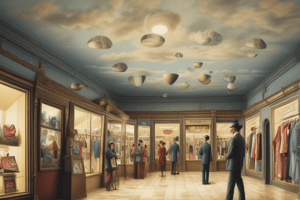Podcast
Questions and Answers
Why is the first step in display preparation so important?
Why is the first step in display preparation so important?
If the merchandise that is selected does not fit with the theme or the style of the display it can be offsetting to the customer, which can lead them not to purchase the item.
Name the four basic types of displays.
Name the four basic types of displays.
The four basic types of displays are those that feature one item; similar products; related products; and a cross mix of items.
Why is a focal point so necessary in display preparation?
Why is a focal point so necessary in display preparation?
It helps keep the eyes moving over all of the merchandise and if it doesn't have a focal point it becomes unfocused.
What is the purpose of visual merchandising?
What is the purpose of visual merchandising?
What are the key elements to visual merchandising?
What are the key elements to visual merchandising?
Why are interior displays important?
Why are interior displays important?
Which type of interior display is most effective for new product introductions?
Which type of interior display is most effective for new product introductions?
What role do visual merchandisers play on the marketing team?
What role do visual merchandisers play on the marketing team?
List five steps to creating a display.
List five steps to creating a display.
What artistic elements function in display design?
What artistic elements function in display design?
Locate complementary and adjacent colors on the color wheel. How do the colors contrast with each other?
Locate complementary and adjacent colors on the color wheel. How do the colors contrast with each other?
How are formal and informal balance achieved in display?
How are formal and informal balance achieved in display?
Why is it important to have a focal point in your display?
Why is it important to have a focal point in your display?
Flashcards are hidden until you start studying
Study Notes
Display Preparation
- Selecting merchandise must align with the display theme and style to avoid customer disinterest and potential lost sales.
Types of Displays
- Four basic display types include:
- Featuring a single item
- Grouping similar products
- Displaying related products
- Creating a cross mix of various items
Importance of Focal Points
- Focal points are crucial for directing customer attention, ensuring all merchandise is noticed.
- Absence of a focal point can lead to a disorganized appearance.
Purpose of Visual Merchandising
- Visual merchandising involves all physical elements used to convey an intended image to customers.
Key Elements of Visual Merchandising
- Essential components include:
- Storefront
- Store layout
- Store interior
- Interior displays
Importance of Interior Displays
- Interior displays play a vital role in self-service sales environments, enhancing customer engagement.
Effective Interior Display Types
- The effectiveness of closed versus open displays for new product introductions depends on both product price and quality.
Role of Visual Merchandisers
- Visual merchandisers are integral to the marketing team, overseeing merchandise presentation, brand image, and design element placement.
Steps to Create a Display
- Five essential steps include:
- Selecting merchandise
- Choosing the display type
- Choosing an appropriate setting
- Manipulating artistic elements
- Evaluating the completed display
Artistic Elements in Display Design
- Key artistic elements include:
- Line
- Color
- Shape
- Direction
- Texture
- Proportion
- Balance
- Motion
- Lighting
Color Theory
- Complementary colors (e.g., purple and yellow) contrast due to their differences yet work harmoniously together.
- Adjacent colors (e.g., blue and blue-green) create a cohesive color scheme while providing distinct visual feels.
Balance in Display Design
- Formal balance achieved by pairing small items with larger ones.
- Informal balance involves grouping several small items with one large item for visual interest.
Focal Points in Displays
- A focal point is essential as it draws initial attention, guiding customer interest toward the display’s key items.
Studying That Suits You
Use AI to generate personalized quizzes and flashcards to suit your learning preferences.




